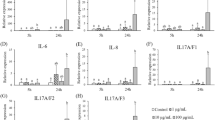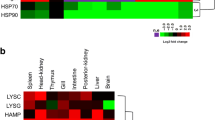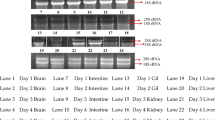Abstract
The Almaco jack (Seriola rivoliana) is a marine fish maintained in mariculture systems and frequently infested by monogenean parasites like Neobenedenia sp. Severe infestations can lead to high mortalities and economic losses for farmers. This study evaluated the effects of temperature on the immune response on Almaco jack infested with Neobenedenia sp. We exposed infested fishes at temperatures of 20 °C, 24 °C, and 30 °C for 20 days and took samples of different tissues at the beginning of the experiment, and after 3 and 20 days. The tissues considered were the skin, thymus, cephalic kidney, and spleen to evaluate the relative gene expression of different genes: Hsp70, IgM, IL-1β, IL-10, and MyD88. Our results showed an increase in IL-1β gene expression in the skin after 20 days of infestation but no significant effect of temperature on gene expression, despite increases in infestation rates with temperature. Therefore, relative genetic expression was controlled by the number of parasites and the days post-infestation. These results show that the parasite infestation induced a local response in the skin, but that temperature has an indirect effect on the immune system of Almaco jack.



Similar content being viewed by others
Data availability
Not applicable.
References
Altman N, Krzywinski M (2015) Association, correlation and causation. Nat Methods 12(10):899–900. https://doi.org/10.1038/nmeth.3587
Beitinger TL, Bennett WA, McCauley RW (2000) Temperature tolerances of North American freshwater fishes exposed to dynamic changes in temperature. Environ Biol Fishes 58:237–275
Bondad-Reantaso MG, Ogawa K, Fukudome M, Wakabayashi H (1995) Reproduction and growth of Neobenedenia girellae (Monogenea:Capsalidae), a skin parasite of cultured marine fishes of Japan. Fish Pathol 30(3):227–231
Brazenor AK, Hutson SK (2015) Effects of temperature and salinity on the life cycle of Neobenedenia sp. (Monogenea: Capsalidae) infecting farmed barramundi (Lates calcarifer). Parasitol Res 114:1875–1886. https://doi.org/10.1007/s00436-015-4375-5
Brazenor AK, Francis DS, Conlan JA, Carton AG, Hutson KS (2020) Temperature alters reproduction and maternal provisioning in a fish ectoparasite. Int J Parasitol 50(10–11):839–849
Buchmann K (1999) Immune mechanisms in fish skin against monogenean- a model. Folia Parasitol 46:1–9
Dinh Hoai T, Thi Trang T, Huong Giang NT (2019) The effects of short freshwater bath treatment on the Susceptibility to Different strages of Neobenedenia girellae infecting barramundi (Lates calcarifer). VJAS 2(3):409–417
Faliex E, Da Silva C, Simon G, Sasal P (2008) Dynamic expression of immune response experimentally infected with the monogenean Diplectanum aequans. Fish Shellfish Immunol 24:759–767
Hirazawa N, Takano R, Hagiwara H, Noguchi M, Narita M (2010) The influence of different water temperatures on Neobenedenia girellae (Monogenea) infection, parasite growth, egg production an demerging second generation on amberjack Seriola dumerili (Carangidae) and the histopathological effect of this parasite on fish skin. Aquac 299:2–7
Hutson KS, Mooney AJ, Ernst I, Brazenor AK, Scheel M, Atalah J (2022) Adecision support tool for parasite management in fish aquaculture. Rev Aquac 14:1656–1670
Laidley CW, Shields RJ, Ostrowksi AO (2004) Progress in amberjack culture at the Oceanic Institute in Hawaii. Global Aquac Advocate 7:42–43
Le Morvan C, Troutaud D, Deschaux P (1998) Differential effects of temperature on specific and nonspecific immune defences in fish. J Exp Biol 201:165–168
Leong TS, Colorni A (2002) Infection diseases of warmwater fish in marine and brackish waters. In: Woo PTK, Bruno DW, Lim LHS (eds) Diseases and disorders of finfish in cage culture. CABI Publishing, London, pp 193–230
Lindenstrom T, Secombes CJ, Buchmann K (2004) Expression of immune response genes in rainbow trout skin by Gyrodactylus derjavini infections. Vet Immunol Immunopathol 97:137–148
Livak KJ, Schmittgen TD (2001) Analysis of relative gene expression data using real-time quantitative PCR and the 2(ΔΔC(T) method. Methods 25:402–408
Mazón-Suástegui JM, Salas-Leiva J, Teles A, Tovar-Ramírez D (2019) Immune and antioxidant enzyme response of Longfin yellow-tail (Seriola rivoliana) juveniles to ultra-diluted substances derived form phosphorus, silica and pathogenic vibrio. Homeopathy 108(1):43–53
Nakayasu C, Tsutsumi N, Oseko N, Hasegawa S (2018) Role of cellular response in elimination of the monogenean Neoheterobothrium hirame in Japanese flounder Paralichthys olivaceus. Dis Aquat Org 64:127–134
Ogawa K, Bondad-Reantaso MG, Fukudome M, Wakabayashi H (1995) Neobenedenia girellae (Hargis, 1955) Yamaguti, 1963 (Monogenea: Capsalidae) From Cultured Marine Fishes of Japan. J Parasitol 81(2):223–227
Pankhurst NW, Porter MJR (2003) Cold and dark or warm and light: variations on the theme of environmental control of reproduction. Fish Physiol Biochem 28:385–389. https://doi.org/10.1023/B:FISH.0000030602.51939.50
Poulin R (2007) Are there general laws in parasite ecology? Parasitology 134:763–776. https://doi.org/10.1017/S0031182006002150
Reyes-Becerril M, Alamillo E, Trasviña-Moreno AG, Hirono I, Kondo H, Jirapongpairoj W, Ascencio-Valle F, Angulo C (2017) In vivo and in vitro studies using larval and adult antigens from Neobenedenia melleni on immune response in yellowtail (Seriola lalandi). J Fish Dis 40:1497–1509
Safran P (1992) Theoretical analysis of the weight-length relationships in the juveniles. Mar Biol 112(4):545–551
Tubbs LA, Poortenaar CW, Sewell MA, Diggles BK (2005) Effects of temperature on fecundity in vitro, egg hatching and reproductive development of Benedenia seriolae and Zeuxapta seriolae (Monogenea) parasitic on yellowtail kingfish Seriola lalandi. Int J Parasitol 35:315–327
Uribe C, Folch H, Enriquez R, Moran G (2011) Innate and adaptive immunity in teleost fish: a review. Vet Med 56(10):486–503
Valles-Vega I, Ascencio F, Sicard-González T, Angulo C, Fajer-Avila EJ, Inohuye-Rivera RB, Pérez-Urbiola JC (2019) Effects of temperature on the life cycle of Neobenedenia sp. (Monogenea: Capsalidae) from Seriola rivoliana (Almaco jack) in Bahía de La Paz. BCS Mexico Parasitol Res 118:3267–3277
Bates D, Mächler M, Bolker BM, Walker SC (2015) Fitting linear mixed-effects models using lme4. J Stat Softw 67(1). https://doi.org/10.18637/jss.v067.i01
Bush AO, Lafferty KD, Lotz JM, Shostak AW (1997) Parasitology meets ecology on its own terms Margolis et al revisited. J Parasitol 83(4):575–583
Fajer-Ávila EJ, Martínez-Rodríguez I, Abdo de la Parra MI, Álvarez-Lajonchere L, Betancourt-Lozano M (2008) Effectiveness of freshwater treatment against Lepeophtheirus simplex (Copepoda: Caligidae) and Neobenedenia sp (Monogenea: Capsalidae), skin parasites of bullseye puffer fish, Sphoeroides annulatus reared in tanks. Aquac 284(1–4):277–280
FAO (2022) El estado mundial de la pesca y la acuicultura 2022. Hacia la transformación azul, Roma. https://doi.org/10.4060/cc0461es
Fulton TW (1904) The rate of growth of fishes. Twentysecond Annual Report. Part III. Fishes Board of Scotland, Edinburgh, 141–241
Gourbière S, Morand S, Waxman D (2015) Fundamental factors determining the nature of parasite aggregation in hosts. PLos ONE 10(2). https://doi.org/10.1371/journal.pone.0116893
Jensen LB, Boltana S, Obach A, McGurk C, Waagbo R, MacKenzie S (2014) Investigatig the underlying mechanisms of temperature-related skin diseases in Atlantic salmon, Salmo salar L., as measured by quantitative histology, skin transcriptomics and composition. J Fish Dis
R Core Team (2016) R: a language and environment for statistical computing. R Foundation for Statistical Computing, Vienna, Austria. https://www.R-project.org/. Accessed 10 Jan 2020
Sicard-Gonzalez MT (2006) Efecto de la oscilación Térmica en la Fisiología de la almeja mano de león (Nodipecten subnodosus Sowerby, 1835). Dissertation, Universidad Autónoma de Nuevo León, México
Trasviña-Moreno AG, Ascencio F, Angulo C, Hutson KS, Avilés-Quevedo A, Inohuye-Rivera RB, Pérez-Urbiola JC (2017) Plant extract as a natural treatment against the fish ectoparasite Neobenedenia sp. (Monogenea: Capsalidae). J Helminthol 93(1):57–65
Acknowledgements
The authors are grateful to Roxana B. Inohuye-Rivera, Rosa I. Vázquez-Sánchez, and Gilberto González-Soriano for your support in experiment design. Margarita Mendoza-Cruz, David Fernández-Sánchez, and Andrea Tecorral-Vázquez for their assistance in maintaining the experimental set. Amaru Márquez-Artavia for statistical advice. Rancheros del Mar for providing juvenile fish. I.V.V. is grateful to CONACYT mobility grant and the financial support of Kampachi farms to make an internship at Princeton University.
Funding
This work was funded by an institutional funding from Centro de Investigaciones Biológicas del Noroeste S.C. (Center for Biological Research Northwest) (PAC) to F.A and J.C.P-U. I.V.V. is a recipient of doctoral fellowship from the Consejo Nacional de Ciencia y Tecnología (CONACYT).
Author information
Authors and Affiliations
Contributions
IVV, JCPU, and FA conceived the idea developed in this manuscript. IVV, JCPU, and TSG participated in the experimental design. IVV and DTR were responsible for the molecular studies. IVV and AG performed the statistical analysis. EF and JPU were responsible for funding this research through their projects. IVV wrote the manuscript with critical input from all authors.
Corresponding author
Ethics declarations
Ethics approval
This study was approved by the authorities in bioethics from Centro de Investigaciones Biológicas del Noroeste (CIBNOR).
Consent to participate
Not applicable.
Consent for publication
Not applicable.
Competing interests
The authors declare no competing interests.
Additional information
Section Editor: Shokoofeh Shamsi
Publisher's Note
Springer Nature remains neutral with regard to jurisdictional claims in published maps and institutional affiliations.
Rights and permissions
Springer Nature or its licensor (e.g. a society or other partner) holds exclusive rights to this article under a publishing agreement with the author(s) or other rightsholder(s); author self-archiving of the accepted manuscript version of this article is solely governed by the terms of such publishing agreement and applicable law.
About this article
Cite this article
Valles-Vega, I., Pérez-Urbiola, J.C., Tovar-Ramírez, D. et al. Immune response of the Almaco jack (Seriola rivoliana) against the infestation with Neobenedenia sp. in three cultivated temperatures. Parasitol Res 123, 127 (2024). https://doi.org/10.1007/s00436-024-08135-y
Received:
Accepted:
Published:
DOI: https://doi.org/10.1007/s00436-024-08135-y




